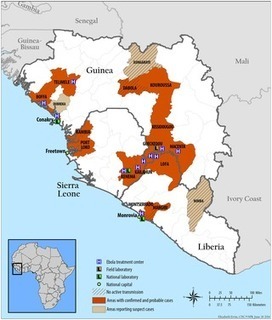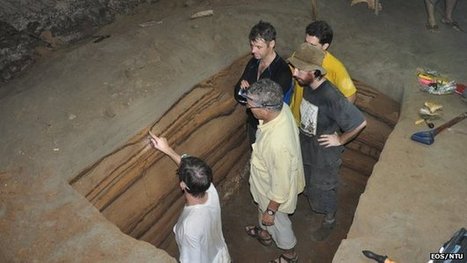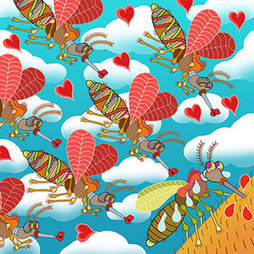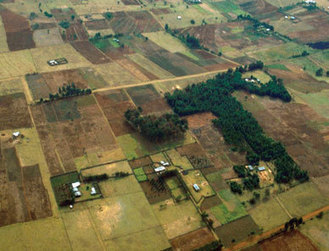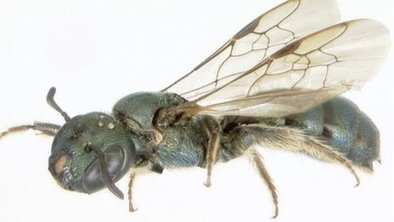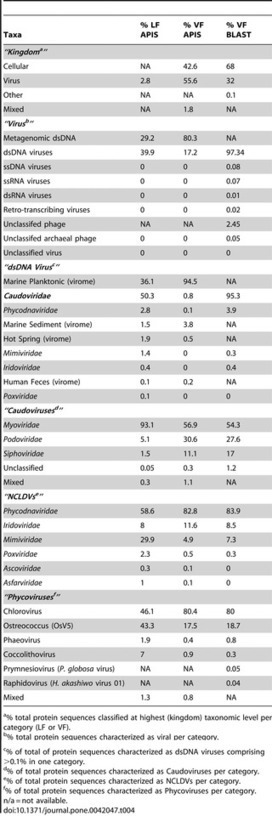 Your new post is loading...
 Your new post is loading...
Poor economies not only produce less; they typically produce things that involve fewer inputs and fewer intermediate steps. Yet the supply chains of poor countries face more frequent disruptions---delivery failures, faulty parts, delays, power outages, theft, government failures---that systematically thwart the production process. To understand how these disruptions affect economic development, we model an evolving input--output network in which disruptions spread contagiously among optimizing agents. The key finding is that a poverty trap can emerge: agents adapt to frequent disruptions by producing simpler, less valuable goods, yet disruptions persist. Growing out of poverty requires that agents invest in buffers to disruptions. These buffers rise and then fall as the economy produces more complex goods, a prediction consistent with global patterns of input inventories. Large jumps in economic complexity can backfire. This result suggests why "big push" policies can fail, and it underscores the importance of reliability and of gradual increases in technological complexity. Contagious disruptions and complexity traps in economic development
Charles D. Brummitt, Kenan Huremovic, Paolo Pin, Matthew H. Bonds, Fernando Vega-Redondo
Via Complexity Digest
Accessing information efficiently is vital for animals to make the optimal decisions, and it is particularly important when they are facing predators. Yet until now, very few quantitative conclusions have been drawn about the information dynamics in the interaction between animals due to the lack of appropriate theoretic measures. Here, we employ transfer entropy (TE), a new information-theoretic and model-free measure, to explore the information dynamics in the interaction between a predator and a prey fish. We conduct experiments in which a predator and a prey fish are confined in separate parts of an arena, but can communicate with each other visually and tactilely. TE is calculated on the pair’s coarse-grained state of the trajectories. We find that the prey’s TE is generally significantly bigger than the predator’s during trials, which indicates that the dominant information is transmitted from predator to prey. We then demonstrate that the direction of information flow is irrelevant to the parameters used in the coarse-grained procedures. We further calculate the prey’s TE at different distances between it and the predator. The resulted figure shows that there is a high plateau in the mid-range of the distance and that drops quickly at both the near and the far ends. This result reflects that there is a sensitive space zone where the prey is highly vigilant of the predator’s position. Information Dynamics in the Interaction between a Prey and a Predator Fish
Feng Hu, Li-Juan Nie and Shi-Jian Fu Entropy 2015, 17(10), 7230-7241; http://dx.doi.org/10.3390/e17107230 ;
Via Complexity Digest, Phillip Trotter
Nature’s large-scale patterns emerge from incomplete surveys, thanks to ideas borrowed from information theory.
The precise factors that result in an Ebola virus outbreak remain unknown, but a broad examination of the complex and interwoven ecology and socioeconomics may help us better understand what has already happened and be on the lookout for what might happen next, including determining regions and populations at risk. Although the focus is often on the rapidity and efficacy of the short-term international response, attention to these admittedly challenging underlying factors will be required for long-term prevention and control.
To determine geographic range for Ebola virus, we tested 276 bats in Bangladesh. Five (3.5%) bats were positive for antibodies against Ebola Zaire and Reston viruses; no virus was detected by PCR. These bats might be a reservoir for Ebola or Ebola-like viruses, and extend the range of filoviruses to mainland Asia.
ALIFE 14, the Fourteenth International Conference on the Synthesis and Simulation of Living Systems, presents the current state of the art of Artificial Life—the highly interdisciplinary research area on artificially constructed living systems, including mathematical, computational, robotic, and biochemical ones. The understanding and application of such generalized forms of life, or “life as it could be,” have been producing significant contributions to various fields of science and engineering.
This volume contains papers that were accepted through rigorous peer reviews for presentations at the ALIFE 14 conference. The topics covered in this volume include: Evolutionary Dynamics; Artificial Evolutionary Ecosystems; Robot and Agent Behavior; Soft Robotics and Morphologies; Collective Robotics; Collective Behaviors; Social Dynamics and Evolution; Boolean Networks, Neural Networks and Machine Learning; Artificial Chemistries, Cellular Automata and Self-Organizing Systems; In-Vitro and In-Vivo Systems; Evolutionary Art, Philosophy and Entertainment; and Methodologies. Artificial Life 14 Proceedings of the Fourteenth International Conference on the Synthesis and Simulation of Living Systems Edited by Hiroki Sayama, John Rieffel, Sebastian Risi, René Doursat and Hod Lipson http://mitpress.mit.edu/books/artificial-life-14
Via Complexity Digest
A cave on the northwestern coast of Sumatra holds a remarkable record of big tsunamis in the Indian Ocean. Scientists are using the site to help determine the frequency of catastrophes like the event of 26 December 2004.
A few years ago, I started looking online to fill in chapters of my family history that no one had ever spoken of.
Biotech, farmer associations key for climate adaptation - panel Reuters AlertNet (blog) LONDON (Thomson Reuters Foundation) - An increasingly extreme climate is presenting new challenges to farmers across the world, and biotechnology and greater...
Nearly 80% of bumblebees imported from Europe carry pathogens that pose a threat to UK native honeybees and bumblebees, say scientists.
A small drop in one species' population can drive others to actually die out.
The 2007-2008 financial crisis, you might think, was an unpredictable one-time crash. But Didier Sornette and his Financial Crisis Observatory have plotted a set of early warning signs for unstable, growing systems, tracking the moment when any bubble is about to pop. (And he's seeing it happen again, right now.)
Via Complexity Digest
UCLA researchers now have the first evidence that bacteria ingested in food can affect brain function in humans. In an early proof-of-concept study of healthy women, they found that women who regularly consumed beneficial bacteria known as probiotics through yogurt showed altered brain function, both while in a resting state and in response to an emotion-recognition task.
|
The students in Anthony James’s basement insectary at the University of California, Irvine, knew they’d broken the laws of evolution when they looked at the mosquitoes’ eyes.
By rights, the bugs, born from fathers with fluorescent red eyes and mothers with normal ones, should have come out only about half red. Instead, as they counted them, first a few and then by the hundreds, they found 99 percent had glowing eyes.
More important than the eye color is that James’s mosquitoes also carry genes that stop the malaria parasite from growing. If these insects were ever released in the wild, their “selfish” genetic cargo would spread inexorably through mosquito populations, and potentially stop the transmission of malaria.
The technology, called a “gene drive,” was built using the gene-editing technology known as CRISPR and is being reported by James, a specialist in mosquito biology, and a half dozen colleagues today in the Proceedings of the National Academy of Sciences.
A functioning gene drive in mosquitoes has been anticipated for more than a decade by public health organizations as a revolutionary novel way to fight malaria. Now that it’s a reality, however, the work raises questions over whether the technology is safe enough to ever be released into the wild.
“This is a major advance because it shows that gene drives will likely be effective in mosquitoes,” says Kevin Esvelt, a gene drive researcher at Harvard University’s Wyss Institute. “Technology is no longer the limitation.”
Starting last summer, Esvelt and other scientists began warning that gene drives were about to jump from theory to reality (see “Protect Society from Our Inventions, Says Genome Editing Scientists”) and needed more attention by regulators and the public. The National Academy of Sciences is studying the science and ethics of the technology and plans to release recommendations next year on “responsible conduct” by scientists and companies.
Gene drives are just the latest example of the fantastic power of CRISPR editing to alter the DNA of living things, which has already set off a debate over the possibility that gene editing could be used to generate designer human babies (see “Engineering the Perfect Baby”). But Henry Greely, a law professor and bioethics specialist at Stanford, says environmental uses are more worrisome than a few modified people. “The possibility of remaking the biosphere is enormously significant, and a lot closer to realization,” he says.
Malaria is caused when a mosquito bite transmits plasmodium, a single-celled parasite. It’s treatable, yet every year, 670,000 people die from malaria, the majority of them young children in sub-Saharan Africa.
James says his mosquitoes are the culmination of decades of mostly obscure, unheralded work by a few insect specialists toward constructing a genetic solution to malaria. It finally became possible this year when scientists in the laboratory of Ethan Bier, a fly biologist at the University of California, San Diego, who is a coauthor of the paper, finally used CRISPR to perfect a molecular “motor” that could allow the anti-malaria genes to spread.
The mosquitoes have two important genetic additions. One is genes that manufacture antibodies whenever a female mosquito has a “blood meal.” Those antibodies bind to the parasite’s surface and halt its development. Yet normally, such an engineered mosquito would pass the genes only to exactly half its offspring, since there’s a 50 percent chance any chunk of DNA would come from its mate. And since the new genes probably don’t help a mosquito much, they’d quickly peter out in the wild.
That’s where CRISPR comes in. In a gene drive, components of the CRISPR system are added such that any normal gene gets edited and the genetic cargo is added to it as well. In James’s lab, practically all the mosquitoes ended up with the genetic addition, a result Esvelt calls “astounding.”
What worries Esvelt is that, in his opinion, the California researchers haven’t used strict enough safety measures. He says locked doors and closed cages aren’t enough. He wants them to install a genetic “reversal drive” so the change can be undone, if necessary. “An accidental release would be a disaster with potentially devastating consequences for public trust in science and especially gene-drive interventions,” he says. “No gene-drive intervention must ever be released without popular support.”
James says the experiment was safe since the mosquitoes are kept behind a series of locked, card-entry doors and because they aren’t native to California. If any escaped, they wouldn’t be able to reproduce.
In fact, the whole point of a gene drive is to release it into the wild, a concept that has long been accepted, at least in theory, by public health organizations including the Gates Foundation. Now that they’re actually possible, however, alarming news headlines have compared the technology to “the next weapon of mass destruction” and even raised the specter of insect terrorism, such as mosquitoes that kill people with a toxin.
Gene-drive terrorism is probably nonsense, at least for now. That’s because even if insect weapons were possible, in practice it’s unlikely a terrorist organization would invest millions in an advanced genetic-engineering program. “I have been thinking quite a bit about bad things you could do with it, and we haven’t come up with anything that would succeed,” says Bier. “There are so many bad things you could do that are easier.”
Instead, Bier and James say they are convinced that engineered mosquitoes should be released as soon as possible, something they hope to do if they can find a community affected by malaria that will agree to it. “Imagine we could design a mosquito that would magically cure cancer,” says Bier. “Well, the fear of getting malaria is the same fear we have of getting cancer. In my opinion the benefits outweigh the risks, and we should move forward as aggressively as we can.”
Via Gerd Moe-Behrens
Footage shows Sao Paulo-based public officer Ricardo Azevedo filling his 'T Power H20’ motorcycle with clean water and water from the polluted Tiete River before going for a spin. He said: ‘The advantage of this motorcycle, which works with the hydrogen that comes from the water, is that the result that comes out of the exhaust is water vapour.
‘This is different from gasoline, which the result is carbon monoxide.’
Via Sepp Hasslberger
This 2009 publication from the FAO’s Forestry and Forest Products Division highlights why emerging infectious diseases are considered to be among today’s major challenges to science, global health and human development. Rapid changes associated with globalization, especially the rapidly increasing ease of transport, are mixing people, domestic animals, wildlife and plants, along with their parasites and pathogens, at a frequency and in combinations that are unprecedented.
As humans transform ecosystems and come into closer contact with animals, scientists fear more viral epidemics
They don't have a three-second memory. And one researcher thinks we've been dramatically underestimating their intelligence all along.
Trophic cascade effects occur when a food web is disrupted by loss or significant reduction of one or more of its members. In East African Rift Valley lakes, the Lesser Flamingo is on top of a short food chain. At irregular intervals, the dominance of their most important food source, the cyanobacterium Arthrospira fusiformis, is interrupted. Bacteriophages are known as potentially controlling photoautotrophic bacterioplankton. In Lake Nakuru (Kenya), we found the highest abundance of suspended viruses ever recorded in a natural aquatic system. We document that cyanophage infection and the related breakdown of A. fusiformis biomass led to a dramatic reduction in flamingo abundance. This documents that virus infection at the very base of a food chain can affect, in a bottom-up cascade, the distribution of end consumers. We anticipate this as an important example for virus-mediated cascading effects, potentially occurring also in various other aquatic food webs.
Via Ed Rybicki
The extensive exploitation of marine resources by modern fisheries (...) has wide-ranging effects on marine ecosystems. Across the world's oceans, size-selective harvesting by commercial fisheries has been a key driving force behind changes in phenotypic traits such as body size and age at maturation (1–3). These changes have altered the trophic structure of the affected ecosystems, disturbed predatorprey relationships, and modified trophic cascade dynamics (3, 4). Phenotypic changes can involve both ecological and evolutionary reactions to the effect of fishing, and there has been much debate about the relative roles of these reactions. This is important because genetic changes could result in long-term reductions in catches. Recent work has provided evidence for fisheries-induced evolutionary changes, with important implications for the sustainability of fisheries. How Fisheries Affect Evolution
Andrea Belgrano, Charles W. Fowler Science 6 December 2013:
Vol. 342 no. 6163 pp. 1176-1177
http://dx.doi.org/10.1126/science.1245490
Via Complexity Digest
Scientists say there was a widespread extinction of bees 66 million years ago, at the same time as the event that killed off the dinosaurs. The demise of the dinosaurs was almost certainly the result of an asteroid or comet hitting Earth. But the extinction event was selective, affecting some groups more than others. Writing in Plos One journal, the team used fossils and DNA analysis to show that one bee group suffered a serious decline at the time of this collision.
Overfishing and pollution are part of the problem, scientists say, warning that mass extinction of species may be inevitable
Farmers will not be allowed to spray widely used insecticide blamed for declining bee population A widely used insect nerve agent will be banned from use on corn and sunflowers in Europe from the end of 2013 as part of an effort to protect bees,...
This paper provides a logical framework for complexity economics. Complexity economics builds from the proposition that the economy is not necessarily in equilibrium: economic agents (firms, consumers, investors) constantly change their actions and strategies in response to the outcome they mutually create. This further changes the outcome, which requires them to adjust afresh. Agents thus live in a world where their beliefs and strategies are constantly being “tested” for survival within an outcome or “ecology” these beliefs and strategies together create. Economics has largely avoided this nonequilibrium view in the past, but if we allow it, we see patterns or phenomena not visible to equilibrium analysis. These emerge probabilistically, last for some time and dissipate, and they correspond to complex structures in other fields. We also see the economy not as something given and existing but forming from a constantly developing set of technological innovations, institutions, and arrangements that draw forth further innovations, institutions and arrangements.(...) Complexity Economics: A Different Framework for Economic Thought
W. Brian Arthur
SFI WP 13-04-012 http://www.santafe.edu/research/working-papers/abstract/36df2f7d8ecd8941d8fab92ded2c4547/
Via Complexity Digest, Ashish Umre
PLOS ONE: an inclusive, peer-reviewed, open-access resource from the PUBLIC LIBRARY OF SCIENCE. Reports of well-performed scientific studies from all disciplines freely available to the whole world.
|



 Your new post is loading...
Your new post is loading...


